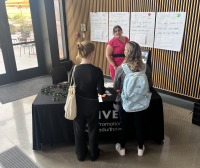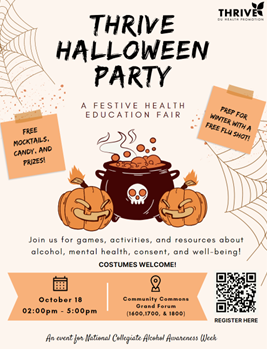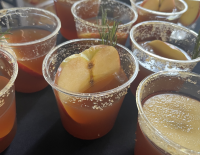
|
Back to Success Stories
Thrive Halloween Party
Hosted by:
University of Denver - Health Promotion Team

Please briefly describe your Communities Talk activity.
The University of Denver’s Health Promotion team hosted a Halloween-themed alcohol education health fair. The event included activities and resources from campus partners such as our student conduct office, student support office, health and counseling center, catering team (which provided mocktails), and collegiate recovery community. The event focused on building skills around ideas like standard drink sizes and safer drinking strategies. We also focused on school-specific data relating to alcohol and how to access resources on campus about preventing alcohol use. This event allowed us to educate directly to students, engage in two-way conversations, and provide a fun Halloween event that was alcohol-free. The event was 3 hours long, and 125 students attended.

How does alcohol and other drug misuse affect your community?

Approximately 80% of University of Denver students use alcohol, according to the 2023National College Health Assessment (NCHA). This shows a need for alcohol prevention and education, especially underage drinking prevention, across our campus. There is also a high use of cannabis, with about 50% of students having used it within the last month.

Which prevention strategy(ies), as defined by SAMHSA’s Center for Substance Abuse Prevention, best fit your Communities Talk activity?
- Information Dissemination Strategy - focuses on improving awareness and knowledge of the effects of AOD issues on communities and families through “one-way” communication with the audience such as speaking engagements, health fairs, and distribution of print materials.
- Education Strategy - focuses on “two-way” communication between the facilitator and participants and aims to improve life/social skills such as decision making, refusal skills, and critical analysis.
- Alternative Strategy - focuses on redirecting individuals from potentially problematic situations and AOD use by providing constructive and healthy events/activities.

What goal(s) did you hope to accomplish with your Communities Talk activity?
- Hold meetings or discussion groups on alcohol and/or other drug misuse prevention.

Did you accomplish your goal(s)?
Yes

What challenge(s) did you face in planning your activity this year?
- Lack of interest from the community

How did you overcome these challenges?
It was hard to figure out how to get students interested in an alcohol education health fair, especially during a busy time of the academic year. After consulting with our team and other teams on campus that create student programming, we changed strategies. Making our event Halloween themed, and also including other fun and important activities like pumpkin carving and flu shots, helped increase student interest. Making it festive and advertising it widely helped us generate more student interest.

What are your next steps?

- Host follow-up meetings or activities
- Create a public education campaign to raise awareness and/or change behaviors around underage drinking (i.e., create PSAs and other promotional materials)

If you’ve conducted Communities Talk activities in prior years, how has your repeated participation contributed to progress in achieving your prevention goals?
This is my first Communities Talk event!

Organizations that conduct Communities Talk activities often involve other organizations in the planning and execution of events. Please indicate which type(s) of organizations you involved in your activity planning.

Which of the following best describes the primary audience(s) for your Communities Talk activity?
- Youth
- Teachers or other education staff

How did you reach and engage your primary audience(s) to encourage them to participate in your activity?
We primarily used flyers and social media posts.

Which Communities Talk resources (or other SAMHSA resources) were most helpful for your activity?

- Communities Talk toolkits
- Communities Talk Find an Activity Map
- Looking at success stories and the events happening within our state helped me brainstorm ideas for our event.
|
|
Return to Success Stories